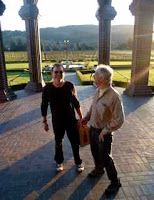
Teachers know that when you really, really want to learn something, it is best to experience it. Learning doesn’t happen just from reading books. Nor does it happen just by listening to lectures. The more ways learners get to experience the new information, the more apt she/he will be to actually learn it.
We are travelling through Northern California in the Sonoma Valley. The land is covered in vineyards and there are wineries abundant. I am learning about wine. That can be dangerous!
We are visiting cousins of Paul who live in Santa Rosa. Andy introduces us to an enormous castle nestled in the town of Kenwood. The castle, built in natural wood and carefully constructed hardware, sits in the midst of acres of grapes growing vibrantly. All the vineyards grow for the purpose of producing wine. The wine here is available only through this winery.

Back in Canada, I have started to bottle my own wine. I go to a ‘wine boutique’ where I talk with Tammy or Will about the kind of wine I want to create. The first batch of 30 bottles was a basic cabernet sauvignon composition. It was hard for me to anticipate the taste and I didn’t really know how to play with the intricacies to make it more exact to the taste I want. The other thing about that first batch is we never really gave it the required chance to age. The freshly bottled wine requires, at least, six weeks to settle. We opened our first bottle within three hours.
The second batch has been sitting in our basement for 3 months now. And the third batch is waiting to be bottled when I return home. I have no doubt that with each batch I make, it will become better and better. The cabernet Sauvignon that is waiting to be bottled now has a significant quantity of cloves that I added to it for a unique flavour.
I am learning how to temper the taste so that each batch tastes more the way I want it to. That takes time because I rely on the small steps that move me closer to the ‘perfect’ taste. The more I learn about how to adjust the taste of the grapes as they ferment, the easier it will be to get to the taste I want. Learning takes time when it happens organically. Patience is necessary.
Mark is our teacher today. We arrive at Ledson Winery about 45 minutes before it closes for the day. Mark is really eager to help us. We are the only tasters on the property. I am interested in learning and Mark is interested in teaching. He also probably smells the probability of a good sell.
“Just tell me the name of the grapes, and let me taste the wine. Then I can learn to differentiate. “ I say to him. He provides.

Chardonnay, Sangiovhese, Cabernet Blanc, Sirah, Merlot, are all names of grapes. Each has its own characteristics. Everything influences the outcome of the final product of the wine. The nature of the soil, the labour of the farmers, the intensity of the sun, all contribute to the healthy growth of the grapes. And then what we do to the grapes, the various ingredients we add to their content, and the way in which we compose the wine are al factors. And time too. Monitoring the time the wine ferments is critical. Not too long, not too short, all within it’s own time…just right.
No doubt I learned a lot about wine. Information that I will eventually be able to apply in my own practise has been helpful. And the experience made it just a little bit more fun. There’s something about wineries that I find very comforting. The grapes grow. They are there for the takers. And they undoubtedly know they are being nurtured purposefully.
We taste 10 different wines as Mark talks us through the process. By the time we leave we are full, a little bit tipsy, and so much more informed about wine. And I understand. I need to experience to learn what I’m learning. What an experience that was!

No comments:
Post a Comment